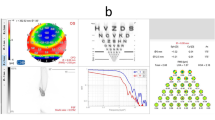Abstract
Purpose
We conducted a cross-sectional study to test the hypothesis that the structural contributions to myopia in preterm and full-term born children are different.
Methods
In this study, 93 children ranging from ages 2 to 13 who had myopia ≥ −3 diopters in at least one eye were examined with A-scans. The following data was collected and analyzed: history of birth, refractive error (RE), cornea thickness (CT) and average corneal curvature (AVK), depth of anterior chamber (ACD), lens thickness (LT), and axial length (AL) of the eye.
Results
Eyes were tested and categorized into four groups: myopic eyes in full-term children (group 1), myopic eyes in premature children (group 2), non-myopic eyes in full-term children (group 3), and non-myopic eyes in preterm children (group 4). The RE were similar between group 1 and group2, and between group 3 and group 4. Myopic eyes in group 2 had higher AVK as compared to group 3; 45.4 ± 0.4 D vs. 43.5 ± 0.7 D, p = 0.008. The ACD in group 2 was shallower than that in group 1 (2.5 ± 0.5 vs. 3.2 ± 0.3, p = 0.01). The LT measurements in group 2 were thicker than those in group 1 (mean LT = 4.9 ± 1.0 vs 4.1 ± 0.3 mm, p = 0.001, respectively). Finally, AL of myopic eyes in group 1 was longer than that of group 2, p = 0.01.
Conclusion
These results suggest that increased axial length plays an important role in myopia in full-term children, whereas corneal curvature and lens thickness are major contributors to myopia in preterm children.



Similar content being viewed by others
References
O’Connor AR, Wilson CM, Fielder AR (2007) Ophthalmological problems associated with preterm birth. Eye (Lond) 21:1254–1260
Achiron R, Kreiser D, Achiron A (2000) Axial growth of the fetal eye and evaluation of the hyaloid artery: In utero ultrasonographic study. Prenat Diagn 20:894–899
Birnholz JC (1985) Ultrasonic fetal ophthalmology. Early Hum Dev 12:199–209
Smith LE, Shen W, Perruzzi C, Soker S, Kinose F, Xu X, et al. (1999).Regulation of vascular endothelial growth factor-dependent retinal neovascularization by insulin-like growth factor-1 receptor. Nat, Med;1390–1395
Ziylan S, Serin D, Karslioglu S (2006) Myopia in preterm children at 12 to 24 months of age. J Pediatr Ophthalmol Strabismus 43:152–156
Iribarren R, Rozema JJ, Schaeffel F, Morgan IG (2014) Calculation of crystalline lens power in chickens with a customized version of bennett’s equation. Vision Res;96:33–8.:10.1016/j.visres.2014.1001.1003
Fierson WM (2013) Screening examination of premature infants for retinopathy of prematurity. Pediatrics;131:189–195. doi: 110.1542/peds.2012-2996
International Committee for the Classification of Retinopathy of Prematurity (2005) The international classification of retinopathy of prematurity revisited. Arch Ophthalmol 123:991–999
O’Connor AR, Stephenson TJ, Johnson A, Tobin MJ, Ratib S, Fielder AR (2006) Change of refractive state and eye size in children of birth weight less than 1701 g. Br J Ophthalmol 90:456–460
Birch EE, O’Connor AR (2001) Preterm birth and visual development. Semin Neonatol 6:487–497
Harayama K, Amemiya T, Nishimura H (1981) Development of the eyeball during fetal life. J Pediatr Ophthalmol Strabismus 18:37–40
Pennie FC, Wood IC, Olsen C, White S, Charman WN (2001).A longitudinal study of the biometric and refractive changes in full-term infants during the first year of life. Vision Res;41:2799–2810.
Gonzalez Blanco F, Sanz Fernandez JC, Munoz Sanz MA (2008) Axial length, corneal radius, and age of myopia onset. Optom Vis Sci 85:89–96. doi:10.1097/OPX.1090b1013e3181622602
Iribarren R (2015) Crystalline lens and refractive development. Prog Retin Eye Res 47:86–106. doi:10.1016/j.preteyeres.2015.1002.1002
Beri S, Malhotra M, Dhawan A, Garg R, Jain R, D’Souza P (2009) A neuroectodermal hypothesis of the cause and relationship of myopia in retinopathy of prematurity. J Pediatr Ophthalmol Strabismus 46:146–150
Iwase S, Kaneko H, Fujioka C, Sugimoto K, Kondo M, Takai Y et al (2014) A long-term follow-up of patients with retinopathy of prematurity treated with photocoagulation and cryotherapy. Nagoya J Med Sci 76:121
Cook A, White S, Batterbury M, Clark D (2003) Ocular growth and refractive error development in premature infants without retinopathy of prematurity. Invest Ophthalmol Vis Sci 44:953–960
Beenett AG (1988) A method of determining the equivalent powers of the eye and its crystalline lens without resort to phakometry. Ophthalmic Physiol Optics 8:53–59
Fledelius HC (1992) Preterm delivery and the growth of the eye. An oculometric study of eye size around term-time. Acta Ophthalmol Suppl:10–15
Author information
Authors and Affiliations
Corresponding author
Ethics declarations
Conflict of interest
All authors certify that they have NO affiliations with or involvement in any organization or entity with any financial interest (such as honoraria; educational grants; participation in speakers’ bureaus; membership, employment, consultancies, stock ownership, or other equity interest; and expert testimony or patent-licensing arrangements), or non-financial interest (such as personal or professional relationships, affiliations, knowledge or beliefs) in the subject matter or materials discussed in this manuscript.
Funding
No funding was received for this research.
Ethical approval
All procedures performed in studies involving human participants were in accordance with the ethical standards of the institutional and/or national research committee and with the 1964 Helsinki declaration and its later amendments or comparable ethical standards.
Informed consent
Informed consent was obtained from all individual participants included in the study.
Rights and permissions
About this article
Cite this article
Bhatti, S., Paysse, E.A., Weikert, M.P. et al. Evaluation of structural contributors in myopic eyes of preterm and full-term children. Graefes Arch Clin Exp Ophthalmol 254, 957–962 (2016). https://doi.org/10.1007/s00417-016-3307-0
Received:
Revised:
Accepted:
Published:
Issue Date:
DOI: https://doi.org/10.1007/s00417-016-3307-0



